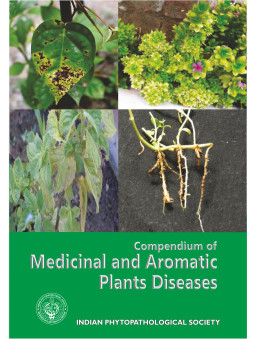Compendium of Medicinal and Aromatic Plants Diseases

| Editors: Rakesh Pandey, Kushal Raj, Goutam Mondal, Ritu Mawar, Alok Kalra and H.B. Singh |
| Year: 2023 |
| Price : INR 1495.00 |
| ISBN: 978-93-94678-03-3 |
About the Book
Medicinal and aromatic plants (MAPs) form one of the important groups due to their demand in various cosmetic, food, flavoring, perfumery and pharmaceutical industries and also to earn foreign exchange by way of export. The area under MAPs cultivation is increasing gradually due to high cash returns and similarity with present agricultural cropping system. Traditional medicaments, derived from plants for thousands of years, are now yielding their secrets and finding important roles in modern medicine. More than three quarters of the world’s population relies mainly on plants and plant extracts for their health care. Of the 250,000 higher plant species on earth, more than 80,000 are having medicinal value. Traditional medicine is widespread throughout the world and is an integral part of each individual’s culture. India’s use of plants for health care dates back close to 5000 years. About 8000 herbal remedies have been codified in the Ayurveda, which is in use in many dispensaries today. Rise in population, inadequate supply of drugs in certain parts of the world, prohibitive cost of treatment for common ailments, side effects of several allopathic drugs in current usage and development of resistance to currently used drugs for infectious diseases have led to increased emphasis on the use of plant materials as source of medicines for the wide variety of human ailments. India due to its wide range of geographical, ecological and biological diversities possesses many species that are directly or indirectly used as sources of herbal, allopathic or homeopathic medicines of the innumerable MAPs some commonly known are. periwinkle, isabgol, ashwagandha, coleus, opium poppy, sarpagandha, kacholam, basil, musli, henbanes, senna, guggal, aloe, kalmegh, sweet wormwood, brahmi, lemon grass, vetiver, patchouli, palmarosa, citronella, mints, geranium, lavender, davana, muskdana, rose, jasmine etc. For some years now, there has been an enhanced inclination towards the cultivation of MAPs to meet the demands of pharmaceutical, food, cosmetic, flavoring and perfumery industries. MAPs provide the basic raw material for the production of herbal medicine, flavors, herbal cosmetics, perfumery etc. Essential oils derived from aromatic plants are now becoming one of the most important export items from many developing countries of Asia. Chemically essential oils are terpenes, which act as carriers of the aromatic substances. Most essential oils also contain camphors, and the more odiferous compounds present in them consist of oxygen derivatives of terpenes, alcohols, esters, aldehydes and ketones. India has enjoyed a pre-eminent position in the manufacture of superior perfumes and aromatics by using essential oils. Diseases caused by variety of plant pest and pathogens like fungi, bacteria, virus/mycoplama/ Phytoplasma and nematodes are one of the important limiting factors in the production of medicinal and aromatic crops. Monoculture, the characteristic feature of these crops, provides congenial environment for one or the other pest/ pathogen, the population of which if unchecked may touch an alarmingly high level and may even wipe out the whole crop. Besides, new agro-technologies like cropping system approach, high fertilizer regimes and irrigation schedule also provide favorable conditions for preponderance of one or the other pest species. The information on various diseases on medicinal and aromatic crops is very much scattered. There are few books at present which comprehensively and exclusively deals with the above aspects on these crops. The present book deals with diseases MAPs and their management in detail using regulatory, physical, cultural, chemical, biological, host plant resistance and integrated methods. The present compendium of medicinal and aromatic plants is extensively illustrated with excellent quality photographs enhancing the quality of publication. The compendium is written in lucid style, easy to understand language along with adoptable recommendations involving eco-friendly components of IPM.
Contents
1. Diseases of Betelvine (Piper betle L.) - Goutam
Mondal, Siddharth Singh, Bandana Mayanglambam, Soumik Mukherjee and Basudeb
Dasgupta (1-10)
2. Diseases of Sarpagandha (Rauvolfia
serpentina L.) - Sanjog Chhetri and Goutam Mondal (11-15)
3. Disease Distribution,
Symptomology and Management in Withania somnifera - Ritu Mawar and
Sangeeta Goyal (16-25)
4. Diseases of Mints - Rahul Kumar Gupta,
Shiwangi Singh, Kajal Singh and Akanksha Singh (26-34)
5. Diseases of Sweet Flag (Acorus
calamus L.) - Siddharth Singh and Goutam Mondal (35-40)
6. Major Diseases of Opium Poppy -
Nikky Deepa and Akanksha Singh (41-47)
7. Diseases of Tulsi (Ocimum
tenuiflorum) - Soumik Mukherjee and Goutam Mondal (48-52)
8. Aonla Diseases and their
Management - Ritu Mawar and D.L. Yadav (53-59)
9. Diseases of Swertia chirayita -
S. Baskey (60-69)
10. Diseases of Vetiver (Chrysopogon
zizanioides) - Poonam Kumari and Akanksha Singh (71-75)
11. Diseases of Coleus
forskohlii Briq. and their Effective Management - Rakshapal Singh, Rajendra
P. Patel, Sumit K. Soni and Alok Kalra (76-81)
12. Phytoplasma Diseases
Associated with Medicinal and Aromatic Plants - G.P. Rao (82-96)
13. Nematode Diseases of
Medicinal and Aromatic Plants - Rakesh Pandey and Kushal Raj (97-130)
14. The Epidemiology and
Management of Emerging Diseases of Cannabis sativa: An Overview - Sujata
Singh Yadav, Abdul Samad and Birendra Kumar (132-147)
15. Diseases of Aloe Vera and their Management - Anil Kumar Saini, Kushal Raj, Subham Saini, Jagdeep Singh and Hemant Kumar (148-156)